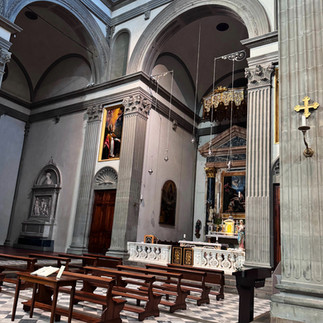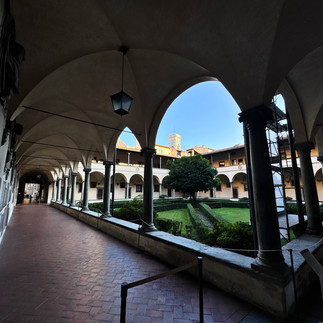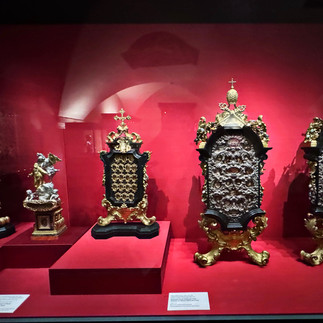
Places of Worship in Florence - Where Art Meets the Divine
Jan 9
4 min read
2
25
1
Florence, the birthplace of the Renaissance, isn't just an art lover's paradise—it's also home to some of the world's most awe-inspiring places of worship. These sacred spaces are not only spiritual sanctuaries but also architectural masterpieces that showcase the city's deep history and cultural richness. From Florence's ancient temples and ornate cathedrals to its resilient synagogue, join me as we explore the beauty behind the city's religious buildings!
Florentia
In ancient Florentia, the Temple of Isis once stood in the Piazza San Firenze, dedicated to Isis, the Egyptian goddess of fertility. She's also associated with Mother Earth, the four seasons, and the cycle of life. Beneath the Baptistery, the Temple of Mars, dedicated to the Roman God of War, also graced the city. Though these temples have long since vanished, both serve as a reminder of the transition from Roman paganism to Christian traditions.
Battistero di San Giovanni & Cattedrale di Santa Maria del Fiore

Octagonal in shape, the Baptistery of St. John sits proudly in front of Florence's famous cathedral and is dedicated to St. John the Baptist. Baptisms were rare, sacred events in the Middle Ages and required for key events, like becoming a citizen or attending church. The building's three doors represent the Old Testament, the New Testament, and the life of St. John.
The majestic Florence Cathedral, Santa Maria del Fiore, is just behind the Baptistery, commonly known as the Duomo. Completed 200 years later, the cathedral is renowned for its stunning dome and façade, crafted from three colored Tuscan marbles—white for faith, green for hope, and red for charity. The structure's pointed arches mark the shift from Romanesque to Gothic architecture, offering a glimpse into the city's evolving artistic identity.



The dome itself, designed by Filippo Brunelleschi, was an engineering miracle of its time.


Giorgio Vasari's Last Judgement fresco—a Renaissance masterpiece—adorns the interior. Vasari passed away in 1574 before completing it, and the fresco was finished by Federico Zuccari from 1576 to 1579. The differences in their painting styles are fascinating to observe, adding layers of history and artistry to this extraordinary structure.


Entering Santa Maria del Fiore and the Baptistery requires adherence to a dress code - covered knees and no bare shoulders, sandals, headgear, or sunglasses.
Basilica di San Lorenzo
The Church of San Lorenzo, Florence's oldest and the parish church of the influential Medici family, was also designed by the famous architect Filippo Brunelleschi. While its façade remains unfinished and modest in appearance, the interior reveals a breathtaking display of artistry and grandeur.



The cloister surrounds an open courtyard.
Behind the church, you'll discover the Medici Chapels.

In the crypt below San Lorenzo, a plaque marks the burial site of the great sculptor Donatello, placed near the tomb of his close friend, Cosimo de' Medici, otherwise known as Cosimo the Elder. Surrounding these tombs are rooms filled with artifacts from the Museum of the Treasury of San Lorenzo, offering a fascinating glimpse into Florence's rich history.

Basilica di San Miniato al Monte
Perched high above Florence, the Basilica of San Miniato al Monte carries with it a fascinating legend. St. Minias was an Armenian prince who became the city's first Christian martyr. He was arrested for refusing to renounce his faith and then condemned to fight wild beasts in the amphitheater. The beasts miraculously refused to harm him, and he was finally beheaded—but the story doesn't end there.
According to legend, Minias picked up his severed head, crossed the Arno River, and walked up the hill to his final resting place, where he wished to be buried. This miraculous act inspired the construction of the basilica that stands there today. With its stunning hilltop location, incredible views of Florence, and marvelous interior, it's one of my professor's favorite locations in the city.

Tempio Maggiore Israelitico di Firenze
The story of the Great Synagogue of Florence is one of resilience and heroism, making it a personal favorite. Originally built to celebrate the emancipation of the Italian Jewish community in 1848, the synagogue boasts a striking copper dome that has weathered over time, now displaying a rich green patina from oxidation.

During World War II, as German troops retreated, they rigged the synagogue with explosives, intending to completely destroy it. However, a courageous neighbor who had befriended the synagogue's patrons risked his life to intervene. Sneaking inside, he disarmed the explosives—leaving just one section active to create a small explosion. This clever act ensured the Germans wouldn't suspect sabotage because they still heard a blast. Thanks to his bravery, only a small part of the synagogue was damaged, and this remarkable monument was preserved.

Like the other religious buildings in Florence, proper dress was required. Shoulders and knees had to be covered. Luckily, I had a sweatshirt with me, even though it was HOT! It was definitely worth sweating through it, though, because the place was stunning and made my list of top 5 places in Florence! Yamacas were required (and provided) inside the temple.
These are just a handful of the many breathtaking religious landmarks around Florence. Stay tuned for Santissima Annunziata, Santo Spirito, Santa Felicita, Sasseti Chapel, Orsanmichele, and more!
Which ones are your favorites? Share them in the comments below!
















































This is pretty cool & inspiring‼️